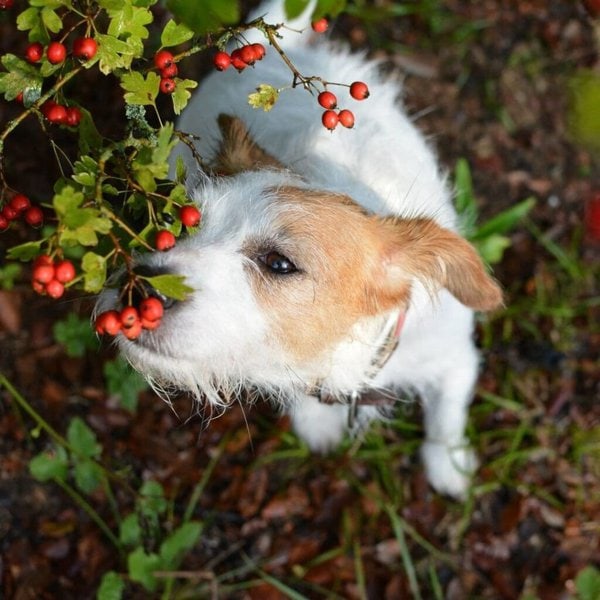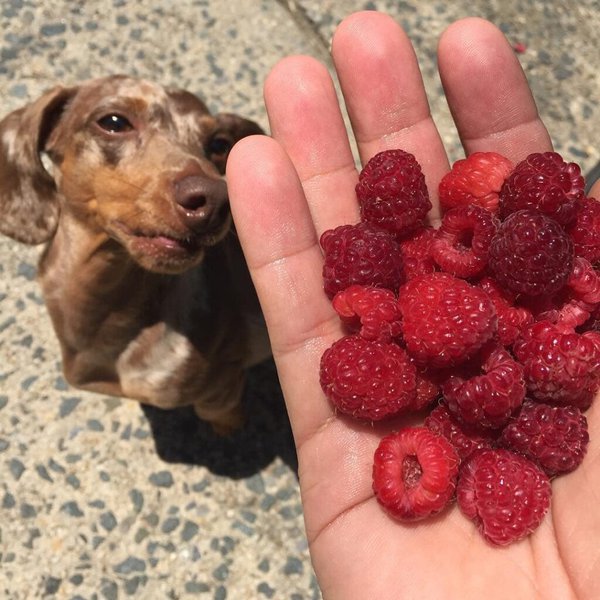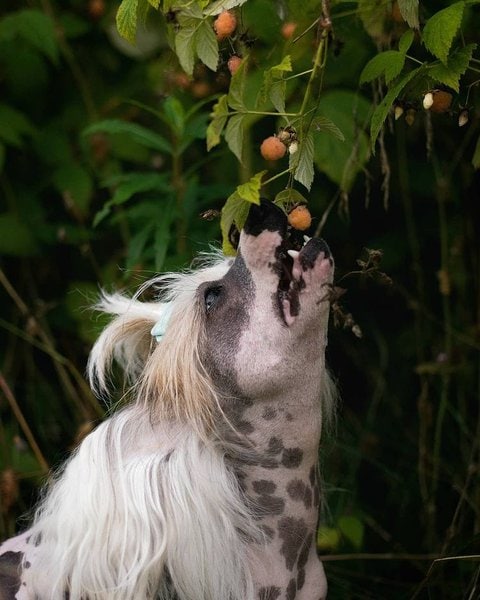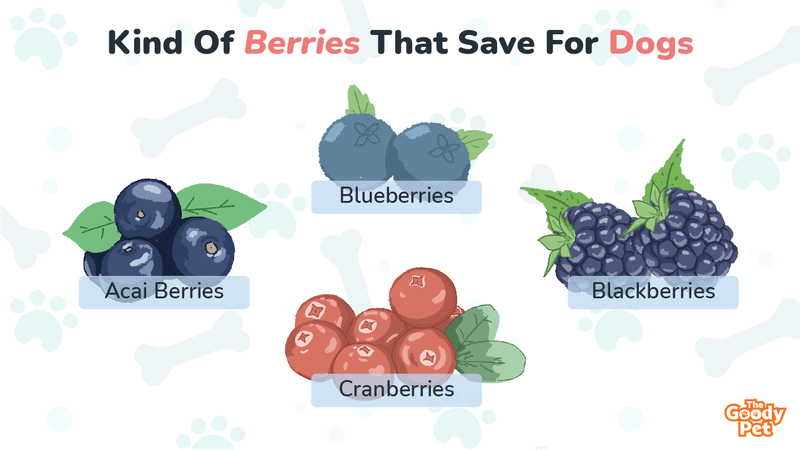Our world’s blessed with over 2,000 different fruits, many of which are berries. But while humans can relish the thought of savoring an almost limitless possibility of tastes, can dogs enjoy the same? Does your pooch share the same privilege of eating multiple kinds of berries as you?
Yes, dogs can eat berries. Berries pack so many healthy vitamins and nutrients beneficial to dogs. However, dogs can eat almost any kind of berry considering that they don’t eat a whole bunch or bowl of it, or else they may suffer from diarrhea or worse symptoms.
Also, there are certain kinds of berries like grapes and salmonberries that look edible but aren’t fit for dogs. So, if you’re looking for a list of healthy berries your four-legged companion can eat, you’d find that right here. You’d also learn what berries dogs can’t eat, what to consider when feeding dogs berries, what to do if your dog eats poisonous berries and if dogs can eat a mixture of berries.
What Berries Are Dogs Allowed To Eat?

Here’s a list of berries that are suitable for dogs’ consumption. Remember that tons of other unfamiliar berries exist throughout the world; however, this is only a list of popular berries around us.
Cranberries
Cranberries are bright red tart berries that are highly beneficial to dogs because of their high vitamin C and acidic content. Consequently, the caustic acid in the berries attacks bacteria in the bladder and serves as excellent protection and cure against UTI— Urinary tract infection.
Although enjoyed by many humans, not all dogs might like cranberries because of the sharp, tangy taste the fruit delivers. However, by adding sweeteners, you could temper the berries’ strong taste and make them more palatable for your dog. Do make sure not to use artificial sugar, and if you must, use only in moderation.
Cranberries could also be turned into juice, serving as a super-healthy liquid product your pooch could lap up with ease, precluding the need for solid treats.
There’s also the dried version of cranberries, which, although suitable for dog consumption, is not highly recommended because many dried cranberry types contain a mixture of other toxic fruits, and most times, too much sugar.
Blackberries
If there’s any fruit out there with very low-calorie content that you can feed to your pooch without worrying about weight gain consequences, it is definitely blackberries.
These berry variants are just so convenient for your pooch, not just because they are juicy and easy to munch and digest but because they also contain massive amounts of antioxidants. And antioxidants have been known to fight off ulcers, prevent accelerated aging, cleanse the digestive tract and help boost your canine pal’s immune system.
Furthermore, antioxidants in blackberries contain anti-inflammatory compounds that combat swellings, most especially in dogs with arthritis.
That said, blackberries contain xylitol which could be potentially harmful to dogs when consumed in significant quantities. And that’s because xylitol causes the excessive release of insulin into a dog’s bloodstream, which in turn reduces the blood sugar levels drastically to the point where the loss of consciousness or coma may occur.
Strawberries
Strawberries are a special sweet treat that your furry buddy would enjoy. They contain antioxidants and vitamins like other berries. However, resident in the inner flesh of the berry is a unique enzyme that exists due to the strawberry’s high malic acid content.
The enzymes in the malic acid contain an acidic bleaching agent that washes off plaque and brightens the enamel in dogs’ teeth.
Undoubtedly, the sugary taste of strawberries would always draw your furry-buddy towards you upon sighting anything round and red-colored. However, don’t indulge when your canine comes begging because the overly sweet nature of strawberries could cause vomiting, diarrhea, and rapid weight gain in obesity-prone dogs.
Before feeding strawberries to your doggie, endeavor to slice them into smaller pieces as this prevents the possibility of a choking hazard. Then, add the strawberry slices atop your doggie’s meal to give that extra delightful taste. You could even have the berries pureed, mixed with yogurt, and served cold.
Blueberries
Blueberries serve as the ultimate summer fruit treat for dogs. Surprisingly, despite their notoriously sweet nature, blueberries still have comparatively low-calorie content and don’t constitute much of a health hazard.
These delicious, tiny round berries have very high vitamin C content, antioxidant, and fiber. Fiber, most especially, aids rapid digestion and therefore prevents excessive hunger that causes overeating in dogs, ultimately leading to unwanted weight gain.
Toss a blueberry in the air now and then and watch your pooch enjoy a game of catch-and-eat. And no, you don’t need to worry about your four-legged companion suffering from a choking hazard as blueberries are small and travel down dogs’ throats with ease.
Generally, the best way to feed blueberries to dogs is to refrigerate them before giving them to your four-legged buddy, so it tastes like a cold, sweet, creamy substance in its mouth.
Remember that only refrigerated blueberries are safe for dogs to consume because frozen berries are hard and could block your doggie’s trachea, preventing proper breathing.
Acai Berries
Acai berries have almost the same color and many nutrients in common with blueberries, so dogs have no problems ingesting them.
However, despite the standard features they share with other berries, acai berries have a unique substance called theobromine which is the same component present in chocolate. And as a vigilant, ever-learning dog parent, you must have heard how chocolate is dangerous to dogs’ nervous systems.
Unfortunately, when dogs consume too many acai berries, the theobromine compound, which acts like caffeine, messes with the nervous system and alters the heart’s rhythmic beat.
As a result, severe reactions in dogs include seizures, coma, and ultimately death, all of which could occur in a fleeting 24 hours.
Conclusively, your dear Fido shouldn’t be eating acai berries, and if at all it does, it should only be in minute quantities.
Raspberries
Raspberries are another kind of popular berry fruit that does not pose a health risk to dogs.
They contain vitamins such as vitamin B-complex that spurs red blood cells’ growth, increases cellular health, and promotes optimum heart function. In addition, they are naturally sweet and juicy, with more moisture than other berries.
Given the raspberry fruit’s sweet nature, it’s imperative that diabetic and obese dogs abstain from these berries because it worsens their health predicament.
Additionally, worth noting is the presence of xylitol in raspberry and the potential threat of low blood sugar that could result when your furry buddy eats too many.
Mulberries
As with other berries, mulberries contain beneficial vitamins, fiber, and other healthy organic compounds that do wonders for your doggie’s system.
Whether green or white, as they commonly appear, mulberries aren’t hazardous to dogs so long as they aren’t consumed in large quantities.
Even so, in cases of overconsumption, dogs might only suffer from mild consequences such as diarrhea and stomach upset, which tend to go away with little or no treatment.
Barberries
Although barberries don’t affect dogs negatively, the plant’s leaves and stems could cause life-threatening problems shortly after ingestion.
The many damaging effects of the barberry plant on dogs have warranted several states to ban the planting of barberries. Hence they aren’t berries that you could find just anywhere.
Conclusively, despite the extreme danger the barberry leaves and stems pose if you happen to find some of the red berries around, feed them to your dear Fido since they help treat diarrhea and help to manage diabetes.
Goji Berries
Fresh or dried, goji berries top the list of beneficial berries to humans and dogs. The berries pack a host of vitamins and nutrients and are especially good for developing strong bones, muscles, and shiny coats in dogs.
The berries can serve as a topping on your doggie’s meals or as a hand-fed treat. Whatever the feeding choice, endeavor to feed goji berries in moderation because they cause diarrhea when eaten in excess.
What Berries Can Dogs Not Eat?

Here are some that have been identified to be dangerous for dogs:
- Salmonberries
- Serviceberries
- Marionberries
- Gooseberries
- Juniper berries
- Holly berries
- Poke berries
- Choke berries
- Mistletoe berries
Generally, wild and unfamiliar berries shouldn’t be fed to dogs. Also, berries with a sharp, pungent smell or hairy stems are probably harmful and potentially hazardous to animals.
What To Do If My Dog Eats Poisonous Berries?
Typically, one or two poisonous berries don’t carry enough potency to affect your four-legged friend’s health. But, say it ate a whole bunch of bad berries, then there’s an increased likelihood your dear Fido could experience life-threatening symptoms.
In such a case, you’d have to call the vet immediately. If possible, carry a piece of the berry fruit so the vet can quickly identify the type of poison and administer the appropriate antidote.
How To Feed Berries To Dogs?
Berries abound in different sizes and shapes, so there isn’t a clear-cut, step-by-step guide to follow when feeding them to your canine pal. However, just like every other fruit, general rules apply when feeding berries to dogs.
So, let’s have a look at some of them.
Wash Berries Before Feeding
From the first stage of the harvest to the final moment when the fruits sit on your kitchen counter, berries pass through many hands and touch many surfaces that harbor many bacteria.
Therefore, thorough washing helps get rid of bacteria like E. coli, which can often be found residing on the surfaces of fruits.
Other times, berries may have aflatoxin, mold that grows on moist food and cause food poisoning in animals. Although washing fruits doesn’t stop the dangerous effect of aflatoxin, it helps to identify it, as you would be able to spot mold while washing fruits.
Cut Berries Into Smaller Pieces
Berries could constitute a choking hazard, especially for small-sized dog breeds like the Chihuahua and the Toy Poodle.
Typically, there are two possible ways a choking hazard could arise. One happens when dogs accidentally sniff up objects, small enough to pass through their nostrils, that inhibit breathing. Two happens when a dog eats or swallows something that lodges in its throat and obstructs the windpipe.
Hence, you’d need to cut up the berries into bite-size portions to prevent all forms of choking hazards from happening.

Feed Berries Slowly For First Time
If your pooch hasn’t had berries before, it’s best to feed at a slow pace so it gets accustomed to the new taste. And that’s because berries could taste bitter, sweet, sour, or somewhere in between, and not all dogs are huge fans of bitter or sour-tasting edibles.
Once you observe that your four-legged buddy is licking its lip and eyeing-begging you after the first trial, you can continue giving it more of the treats. However, ensure not to provide it with too many berries at first since you can’t tell the aftermath effect yet.
The key here is to hand-feed the berries so you dictate the pace and prevent your dear Fido from consuming lots of treats during its first time.
Observe Your Pooch
All caring dog parents are keenly observant of their dogs, especially when they introduce a new meal or treat, like berries, for the first time. However, the truth is all might not go well, and there could be the possibility of allergies and food poisoning after successfully introducing berries as treats for the first time.
Hence, close observation helps you detect any slight changes in your doggie’s health early, leading you to seek help before things go out of control.
Remember that time taken for your canine pal to react adversely to new berries could take anything from 24 hours to three days.
Feed Berries In Moderation
Berries, like other fruits, should only constitute 10% of your canine friend’s diet, no matter how beneficial. And that’s because dogs chiefly evolved to eat animal protein and don’t have the biological makeup to digest lots of plant food.
Also, acai berries and blackberries contain theobromine and xylitol, respectively, both of which will diffuse into a dog’s bloodstream, causing nervous disorder and low blood sugar. Hence there is a need for dogs to eat such berries in smaller portions.
Conclusively, many berries contain fiber in massive proportions, leading to stooling and vomiting in dogs that devour large quantities.
Can Dogs Eat Mixed Berries?
Yes, dogs can eat a combination of berries so long you’re aware that there are no toxic berries in the mixture. The same also applies to blended berry juice and sauce, especially the packaged ones. If you’d like to feed a blend of berries to your furry pal, do the selecting and blending yourself.






